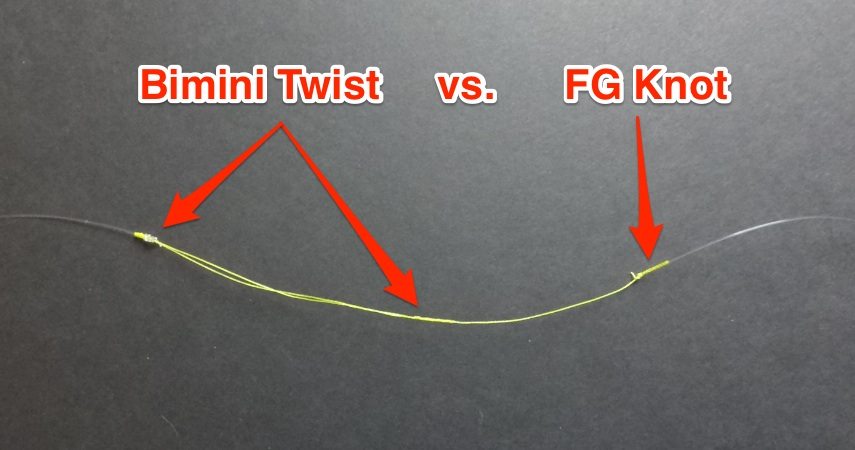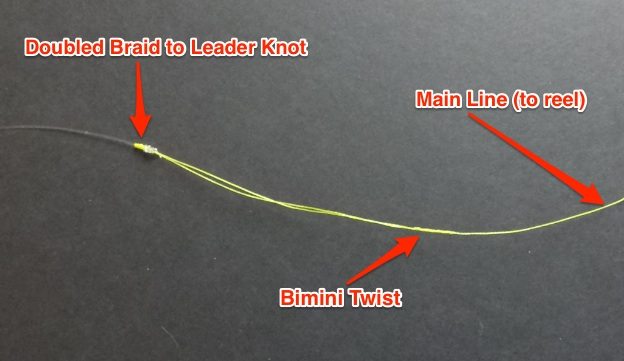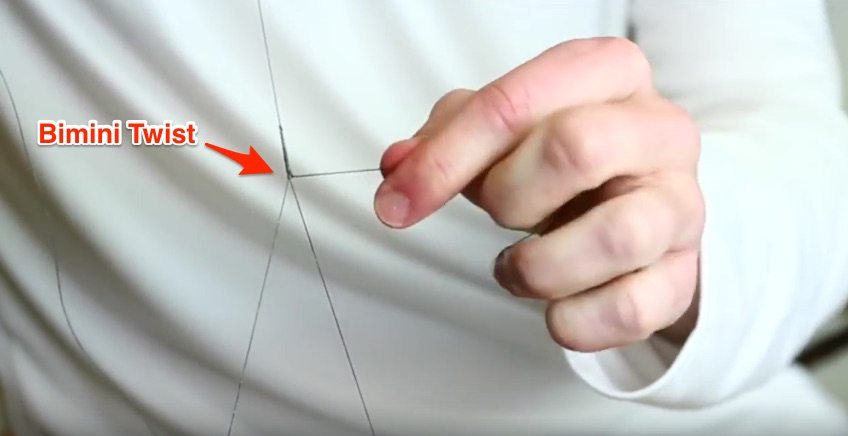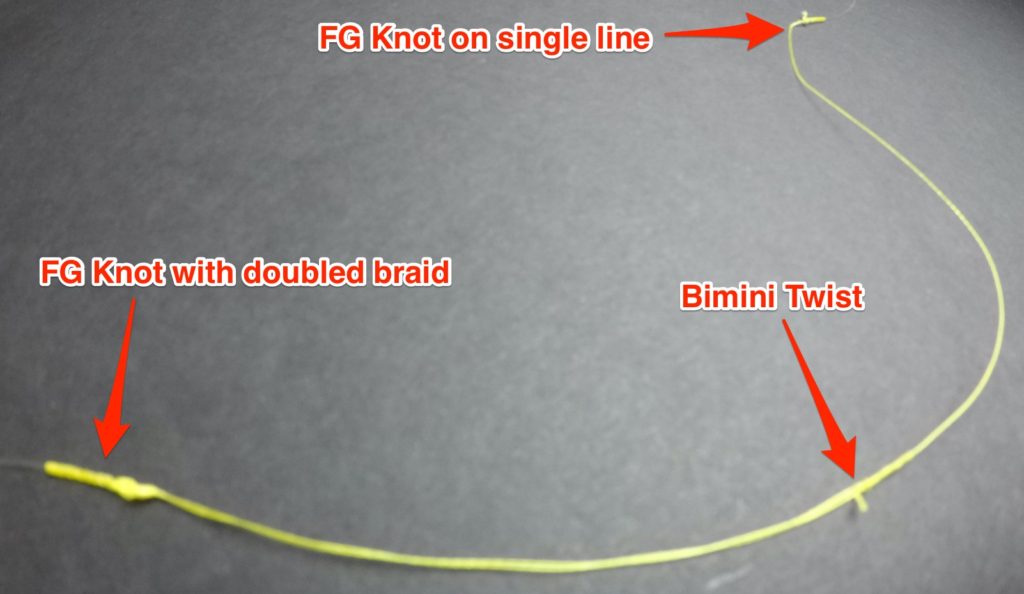FG Knot Vs. The Bimini Twist [Strength Test]
- By: Luke Simonds
- on
- Found In: Braid to Leader, Fishing Knots, Fishing Tips, Knot Contest

It’s fishing knot contest time again!
My favorite thing about knot contests is that every once in a while I get completely surprised by the results.
And my latest knot contest certainly proved to be one of the contests that opened my eyes to a potential next strongest knot for the most important connection for saltwater anglers…
This latest knot contest was focused on testing the top performing line doubling knot (Bimini Twist) to the top performing single braid to leader knot (FG Knot).
Best of all, any increase in strength resulting in this test will have a direct impact to the strength of many saltwater anglers’ overall line systems since many of us use a light braided line for our main line (to maximize casting performance) with a heavier leader that can withstand the sharp/rough mouths of our target species.
But before getting to the surprise, let me first explain this contest so you can understand the purpose of the test.
FG Knot Vs. Bimini Twist Overview
As many of you know, the FG Knot won my original knot contest along with all of the other direct braid to leader connection contests.
Similarly, the Bimini Twist won the most recent contest that focused on line “doubling knots” used for tying line to leader knots with doubled line (which is supposed to be stronger).

Knowing that these are two of the strongest overall fishing knots, I decided to go ahead and actually test the top single line to line knot against the top line doubling knot paired with some of the top doubled-line to leader knots that members of the Salt Strong Fishing Tribe recommended.
Here are the four knots I combined with the Bimini Twist (to compete against the FG knot):
- Improved Bristol (aka. No Name Knot)
- Uni-to-Uni (aka. Grinner Knot)
- Yucatan
- Albright
Notes:
(1) For connecting the braid to the leader, the Bimini Twist was first tied to form a loop at the end of the braid. Then, each of these knots were used to connect the braid loop to the leader before testing its strength against the FG Knot.
(2) I used a range of 20 to 30 twists in the Bimini Twist to see if it made a difference.
FG Knot Vs. Bimini Twist Results

Since the braid to leader knot using the doubled line technically has two core variables (strength of the Bimini Twist + strength of the Loop-to-Leader knot), I did three rounds of tests for each finishing knot.
Note: All tests were done using 10 lb PowerPro for the braid and 30 lb Berkley Big Game mono for the leader.
Test 1 – Improved Bristol Knot
The Improved Bristol knot is similar to the Bristol, but instead of making 10 wraps in one direction before bending back…
The improved version makes the initial 5 wraps, but then reverses the next 5 wraps over the first similar to a Crazy Alberto Knot.
Improved Bristol + Bimini vs. FG – [Results]
- FG Knot won at 12.6 lbs
- FG Knot won at 13.2 lbs
- FG Knot won at 13.5 lbs
Findings: Although the breaking point was higher than the listed strength of the light braid, I would not recommend using the Improved Bristol Knot because the others had higher breaking strengths while also being a bit easier to tie (it’s tough to do the 5 wraps over the first 5 with mono).
Test 2 – Uni to Uni Knot (aka. Double Uni Knot)
The Double Uni Knot knot is probably the most popular of all fishing knots because it can be used for almost any connection.
And it’s strength is often tested as one of the top contenders.
Note: The standard wrap count for this knot is 5 turns each, but I did 10 turns on the braid loop since me prior testing of the double uni showed that doubling the count on the braid side adds strength.
Double Uni + Bimini vs. FG – [Results]
- FG Knot won at 17.5 lbs
- Double Uni Knot won at 18.1 lbs
- FG Knot won at 17.9 lbs
Findings: Although the Double Uni Knot won a bout, the FG knot still pulled ahead in the official 3 tests (plus most of the prep ones too).
Test 3 – Yucatan + Bimini vs. FG Knot
The Yucatan is what many claim to be the strongest option for connecting a doubled main line to a leader.
Note: In order to maximize the strength of this knot with braid, I made 10 to 14 wraps (vs. ~5 that many online tutorials show) around the leader since braid has less friction than mono.
Yucatan + Bimini vs. FG – [Results]
- FG Knot won at 17.7 lbs
- FG Knot won at 16.5 lbs
- FG Knot won at 17.1 lbs
Findings: Of all the loop knot connector knots I tested, this has been my favorite to tie since it’s much quicker than the double uni while having a comparable strength… but it’s still not as quick and strong as the FG knot based on this test.
Test 4 – Albright + Bimini vs. FG Knot
The Albright knot is another very popular knot used for connecting a doubled main line to a leader.
Note: In order to maximize the strength of this knot with braid, I made 10 to 15 wraps around the leader since braid has less friction than mono.
Albright + Bimini vs. FG – [Results]
- FG Knot won at 15.9 lbs
- FG Knot won at 15.5 lbs
- FG Knot won at 16.5 lbs
Findings: Although the Albright + Bimini connection provided a higher breaking strength compared to the line’s listed value, I still prefer the FG Knot since it proved to have a higher breaking strength while also being quicker to tie compared to having to tie both the Bimini and the Albright for the doubled connection.
The Big Shocker!
Given that the FG knot won 11 of 12 head to head contests, I concluded that the FG Knot was superior to the Bimini Twist.
But before I completed this article, I decided to see how the FG Knot would do on the doubled line behind the Bimini Twist instead of the more commonly used knots specified above.

And I was shocked at the results….
The doubled line FG Knot with the Bimini beat the single line FG knot every time.
Final Conclusion
Given that final test, I finally found a braid to leader connection that consistently beats the standard FG knot.
But it required the FG knot to be tied onto a doubled line behind the Bimini twist.
So although the Bimini Twist was the main consistent factor in all four sets of the earlier tests, it was not the root cause weakness.
And since the surprise finding happened at the very last second, I’ll have to dig into the specifics in a different knot analysis exercise… my hunch is that the FG knot did the best job at making sure the Bimini’s coils did not shift.
Good news: We finally found something that beats the standard FG knot.
Bad news: We still have some more analysis to do for determining exactly what doubled line knot is the absolute best for this very important connection for saltwater anglers.
P.S. – If you think your angler friends or fishing networks would like to see this, please Tag them or Share this with them. You Rock! Pa-POW!
Related Posts:
Go To Our Knot Testing Homepage [Full Knot Rankings]
Related categories:
STOP WASTING TIME ON THE WATER!
Do what the “SMART ANGLERS” are doing and join the Insider Club.
Here’s what you’ll receive today when you join:
- Weekly fishing reports and TRENDS revealing exactly where you should fish every trip
- Weekly “spot dissection” videos that walk you through all the best spots in your area
- Exclusive fishing tips from the PROS you can’t find anywhere else
- Everything you need to start catching fish more consistently (regardless if you fish out of a boat, kayak, or land).









we always twisted up the double line tight before doing the wraps and making the twist. Makes the leader a single strand when released. Have to stretch it out straight before releasing or it will spin up in a mess.
Have you ever done a strength test on FG Knots tied under tension as your videos show as opposed to ones done without tension, i.e. like Tackleguys and others show?
The resulting knot is the same thing, so any differences are going to be slight and any nuances will be from how well the person who tied the knot did in keeping the coils as consistently packed as possible… this is where the tension method has the advantage because it helps keep the coils consistently wrapped under the same tension so that no weak spots get accidentally formed.
When I used to tie the FG knot the manual way, I would often get breaking strengths in the 16 to 20 lb range, and once I began using the tension method the range constricted to 18 to 20 lbs.
Hi Luke
Thanks for the quick reply. Will tie my Bimini as always then use the FG to tie on my leader material. Just started to use Braid after many years. FG is fast and a piece of cake. What a nice knot. I tied a loop on the end of my braid which made it super easy to hold onto with my teeth.
“But it required the FG knot to be tied onto a doubled line behind the Bimini twist”
I apologize for not understanding this. Could you clarify behind VS ahead for me? So as usual I would tie my Bimini then use the FG to leader?
Yes, it required the FG knot to be tied behind the bimini twist… meaning that from the rod tip, there would first be the bimini twist which doubles over the line. And then the FG knot is tied to the leader using the doubled line section behind the bimini twist.
I have been a dedicated mono guy for years surf fishing the Outer Banks (specifically Cape Hatteras, a.k.a “The Point”) It was always a bimini to the bristol for drum fishing with 8 and bait and glass minnows directly to the running line via the rapala knot for spanish mackerel and bluefish. This last trip, I switch to 10# braid on my spanish gear for casting distance. I struggled with connecting to a flouro leader (to my statisfaction at least). This is the knot I’ve been looking for. I’m really intrigued by your last finding. The bimini to the FG. I can tie a bimini at night in the rain with ease. I’ve actually practiced the knot at home, at night, in the rain. Yeah, I’m that sort of dude. So, keeping that knot in my mix is a bonus.
Given my novice status in the braided line and FG knot arena, could you expand on tying the FG to the bimini? Do you have a video of it?
Findings: Although the Albright + Bimini connection provided a higher breaking strength compared to the line’s listed value, I still prefer the FG Knot since it proved to have a higher breaking strength while also being quicker to tie compared to having to tie both the Bimini and the Albright for the doubled connection.
if the bimimi was stronger why doesn’t it show it anywhere?
Have done extensive knot testing for 10 years and the PR knot beats out the FG knot, not so much in strength but in consistency. The PR knot is unbeatable in consistency and strength.
Would also respectfully suggest you guys stop “fiddling” around with 10 lb test . Who uses that for salt water fishing. Well maybe Sardine jiggers or Anchovie hunters. We use a minimum of 20lb test leaders to 30-40 lb spectra. Buy a Rapala digital fish scale .
0-50 lbs. $25.00.
Also would suggest you just try tying the FG with a doubled line and forget the Bimini. Also flatten out the spectra by running it through your thumb and index finger nails to get all the twists out of it.
Here is some food for thought: Knot performance does vary between lb. test and between manufactures. Different test wts. and manufactures will significantly alter a knots performance. That is why it is important to standardize your material and mfg.
Walt Galen
Costa Mesa , Calif.
Thanks for the tip on flattening out the spectra. I’ll be sure to try that out along with the doubled line FG knot next chance I get.
I have not yet tested the PR knot because it requires a device (bobbin) to tie it and I get slammed enough when showing the FG knot from people who say it takes way too long to tie… PR looks to take much longer even with the tool.
The 10 lb braid is what I personally use for saltwater fishing so that’s what I use for the testing. It allows for much longer casts compared to 30 to 40 lb braid and has enough strength to handle big fish too (even landed a ~50 lb tarpon on it). And when using just 20 lb leader, my loop knot on the leader will break before my FG knot on the 10 lb braid so I wouldn’t add any overall strength to my line assembly if I did increase the strength of the braid (the loop knot would still be the weakest link).
Yes, I completely agree that knot performance varies based on line brands, types, and sizes. Given that large amount of options, I always recommend that anglers test out their knots on the lines they choose to use. The tests I publish are simply showing the results I’m finding with the lines that I’m using.
I agree with trying these knots with heavier line. My tests are showing that I’m either trying spider hitches and Bimini twists wrong or these knots don’t perform well with braid line stronger that 65# (I get good results with straight 80# mono and fluoro so I can tie a spider hitch or Bimini twist on mono and fluorocarbon ). When I tie a spider hitch or Bimini with 65+# test braid I don’t get more than 50% knot strength. It’s fine if I use <30# braid. Seems like this is why PowerPro doesn’t suggest using these line doubling knots on their website for tying to leaders. I’m still kind of confused why these knots fail, maybe the stronger line cuts itself easier. Ive tested with PowerPro, Maxcuatro and Hollow Ace all 65-100# to 40-100# Monofiliment and fluorocarbon.
Try the Royal Polaris knot
That looks identical to the Crazy Alberto knot from the videos I’ve seen of it. If that’s true, the FG tested to be 30% stronger.
Where did the bimini to bristol fail?. Main line at the bimini or did it break apart at the loop? Same question for bimini-uni combo.
The breaks occurred at the top of the bimini when testing the Bristol. And the Uni knot test had failures at the top of the bimini connection on one and the other two had a failure at the top of the Uni knot where one of the legs broke.
The Bimini breaks at the top of the Bimini because that is where the switch back occurs which applies excessive cutting force to the standing line. You need more internal knot friction to reduce the cutting force at the switch back,,,,Increase you turns on the Bimini to at least 50. That will help increase the knot strength.
This is absolutely correct. Based on the test results you have either not repetitions to be statistically relevant or there is large variations in the knots themselves. Example: you have the bimini part breaking at knots that are less than the FG knot but then you have the bimini holding well past the FG strength. The knot holding the leader is irrelevant if the bimini is breaking prior. Yet you also have the bimini holding past the strength of even the FG knot in the fg vs fg +bimini. This shows a large variation in the bimini knot strength from one example to another. This of course is only true if you are using the exact same spool of braid. If not then all these tests are basically worthless. You m u st use the sample exact spools or at least lot numbers of braid and leader for any of this to hold any significance. Let’s assume it’s the case. But if the bimini breaks at its knot and then in another does knot there must be variations significant enough M are the results in conclusive.
You also can not work in absolute terms as there is ALWAYS an error rate. If you take just the braid spool and test its break strength 10x what is the SD var and ES variation. If you get any result between knots inside this its validity needs more testing to see the over all trend curve. Further the “rated” strength of the lines is meaninglessl. Many lines especially in the USA market are way under estimated to make thier lines look stronger. The same line in the JPN market on a number of lines is changed to be much more accurate to real world. Lookcat PowerPoint. 15lb V2 x8 is 50% stronger than its rating.
Point being first you must do break testing of both the spool of braidcand leader. It must be done enough to be statistically significant i,e. 10x. You then can take the mean with an +/- error rate/variance. Next you need to do the samecwith only the bimini taking the loop as double to wind on the fixture so you are testing the actual knot. Once again 10x. Now you have its variation. Now you can test just the fg knot but with the leader strong enough to cause it to fail at the braid same number. If you compare the fg and bimini results you will know which us stronger at the knot cross over. If the bimini shows to break at a lower force taking into account the knots strength variation there is no need to test the bimini + anything in comparison to the FG as its shown to be weaker. Of course as pointed out the tying must be very consistent.
This brings up another point if a knot is harder to tie consistently, then a slightly weaker knot that has a significantly more consistent break point is possibly a better choice as you can always increase line strengths to compensate. Having a knot that breaks from 15-21lb is less reliable then a knot that breaks at 14-15lb. I will always take the latter and simply use stronger line to increase tontge actual strength I need for my target.
When these articles are written they must have at least photos of each break and the tension force of each break. Without it they are of little value especially when combining knots such as bimini + xxxxx examples.